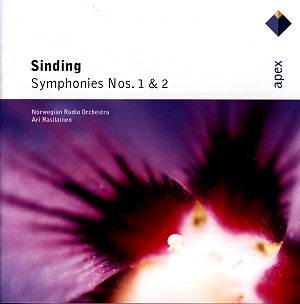Sinding is a bigger figure than The Rustle of Spring
(Frühlingsrauchen), the miniature that once could be
found in every domestic piano stool, could ever hint. There are four
symphonies, the last dating from 1936. The are also three violin concertos
(1898, 1901, 1917), upwards of 240 songs, an opera Der Heilige Berg
(performed in Dessau in 1914 and in Oslo in 1931) as well as a Piano
Quintet (1882-84).
His first two symphonies were written around the axis
of the turning century. The First is splendidly surging and has a fine
broad-leaping theme in the first movement which has something about
it of early Tchaikovsky (symphonies 1-3) and of Schumann and Grieg.
The Scandinavian character is also unmistakable. The other influence
is that of Stenhammar recognisable from hints of pastoral breezes and
bracing headlands. There is a lovely andante. Vivace’s ‘folk shivers’
include an aspiring theme in which the allegro moderato is referred
back to. This happens again in the finale. Indeed the sense of symphonic
cohesion is remarkable especially if you were expecting something ramshackle
as befits a miniaturist with ideas above his station. The Second Symphony
is not quite as impressive. The accents are now strongly Wagnerian (Meistersinger)
mixed with hints of Schumann from the Second and Third symphonies. This
carries less conviction than its predecessor. The concluding Allegro
is fresh and charming, full of confident bustling energy. The middle
movement is in an easy-as-she-goes generalised romantic idiom with nothing
I associate with Scandinavian nationalisms. It is, from this point of
view, a little like Haakon Børresen's second and third symphonies
- blandly conventional and sometimes salon-like. Apart from some Straussian
horn writing and some imaginative little touches such as the whisper
of violins at 4.48 in the finale. Otherwise that finale might be from
one of those ceremonial finales with which Glazunov decked out his sixth
and eighth symphonies.
This still leaves me wondering expectantly about the
other two symphonies and the violin concertos.
I have not heard the competing versions of these two
symphonies by but this one at bargain price is admirably attractive
and is given vitality by Rasilainen and his Norwegian orchestra.
Rob Barnett

